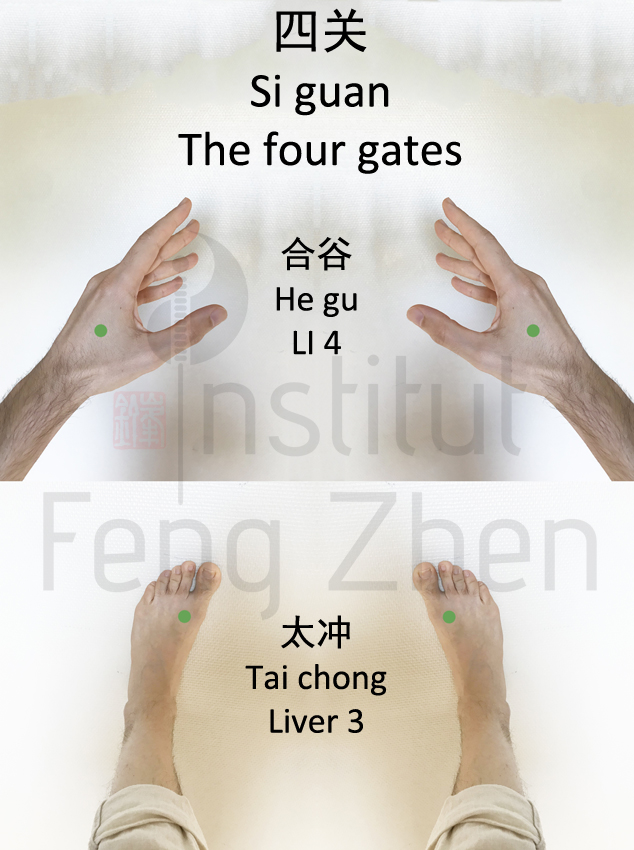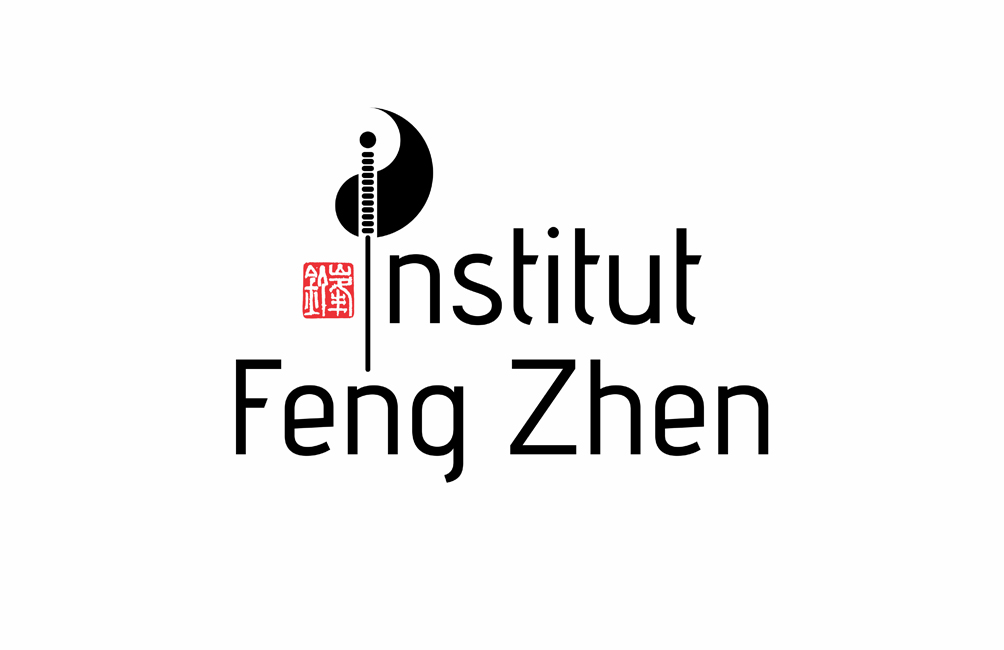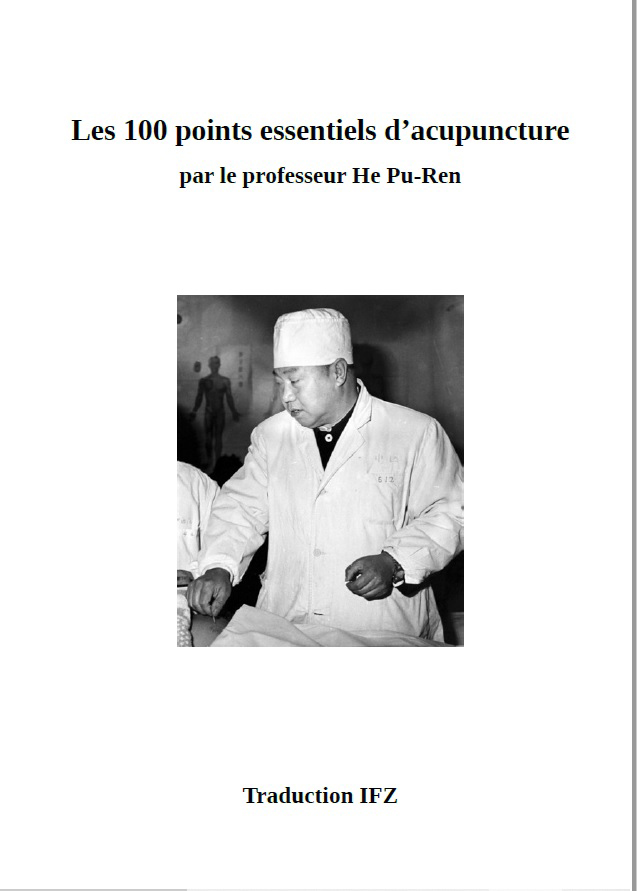The four gates
“Si guan" - The four gates

1 / Introduction
“Si guan – the four gates”, are formed by the association of He gu (LI4) and Tai chong (L3) acupoints. He gu (LI4) is the yuan – source point of the arm yang ming large intestine channel. It is one of the four general points ("si zong xue"). He is located on the back of the hand, in the space formed by the junction of the thumb and index finger's metacarpal bones. Tai chong (L3) is both the yuan – source point and the shu – river point of the leg jue yin liver channel. He is located on the dorsal aspect of the foot, in the space formed by the junction of the metatarsal of the big toe with the second toe. They are two very important acupoints of the human body. Together, they bear the name of “Si guan”, the “four gates”.
The first occurrence of this combination is found in the "Zhen jiu da cheng" (1601), in the chapter on non-regular points, in these words: "Si guan, it is Tai chong (L3) together with He gu (LI4) ".
Due to its location on the yang ming channel, He gu (LI4) is full of qi and blood. He is effective to tonify as well as to disperse qi, and to promote blood circulation. Due to its location on the jue yin channel, Tai chong (L3) has few qi and a lot of blood. He is effective to nify and to regulate the blood.
2 / A traditional method to pair acupoints
The association of He gu (LI4) and Tai chong (L3) synthesizes several traditional methods of combining pair acupoints:
Yin (Tai chong L3) - Yang (He gu LI4)
Qi (He gu LI4) - Blood (Tai chong L3)
Organ zang (Tai chong L3) - Organ fu (He gu LI4)
The upper part of the body (He gu LI4) – The lower part of the body (Tai chong L3)
It is a classical method to gather yin yang. Up and down are associated, qi and blood are balanced, Zang fu organs are regulated. The yin yang balance is restored.
The effects obtained when He gu (LI4) and Tai chong (L3) are punctured together vary according to the needle technique applied. Depending on the method, they can have the following therapeutic faculties: drive out the wind by opening the surface (diaphoretic), opening the chest to regulate the circulation of qi, tranquilize and soothe the mind, promote blood circulation and break down stasis, clarify heat and drain moisture, promote transit, promote the menstrual cycle and circulation of luo to stop pain, disperse the lungs and transform phlegm, soothe asthma, drain the liver and support the gallbladder to remove obstructions, tonify qi and increase blood, smooth the liver and support the kidneys.
3 / The "yuan – source" points
According to the theories of traditional Chinese medicine, He gu point (LI4) is the yuan – source point of the arm yang ming channel, and Tai chong (L3) the one of the leg jue yin channel. The “Nan jing” tells us more about the “yuan – source” points:
“Below the navel and between the kidneys moves the qi, from which life develops. Likewise, the roots of the twelve channels are called "yuan – source". Yuan – source, is also the title given to the san jiao – triple warmer. So, the places where they accumulate form sources. Therefore, when one of the five zang or six fu organs is sick, one should always selects its belonging "yuan – source" point.
Yuan points are the places where the qi and blood of the zang fu organs converge. They are crossed by the primordial qi (yuan qi). Yuan qi aggregate more on this places; therefore, it is like reservoirs. Furthermore, yuan – source points are closely related to primordial qi (yuan qi). It is precisely from their ability to promote the primordial qi on all the three cavities, that He gu (LI4) and Tai chong (L3) are unable to do their countless therapeutic effects.
4 / "Biao ben – root ending" interaction
The association of points called “Si guan” is also related to the theory of communication networks of qi called “biao ben” (ending & root). He gu (LI4) and Tai chong (L3) are both found on the “ben” (root) parts of their respective channels; located below the elbows and knees. According to the course of the qi in the channels, and their connections with the zang fu organs, they have close relationship with the "biao" (termination) parts; either the head and the trunk.
The ancients named the combination of He gu (LI4) and Tai chong (L3) “Si guan – the four gates” to emphasize the importance of the points below the elbows and knees, as well as to highlight some of their specificities. In clinic, “Si guan – four gates” are used to treat diseases of the face (such as headache, facial paralysis, hemifacial spasm, etc.) and trunk (such as palpitations, chest distress, gastroesophageal reflux, etc.) with great success.
5 / Therapeutic applications of "Si guan - four gates"
a / The aucpoint “Si guan – four gates” deal with facial neuralgia. From what we've just said, it's obvious. The "Ode of the Jade Dragon": "No matter what syndrome affects the face, a needle at He gu (GI4) works like a charm." The main actions of He gu (GI4) are to regulate qi, to drive away the wind and clear the heat, and to wake-up the mind. The main actions of Tai chong (F3) are to regulate the blood, smooth the liver and extinguish the wind, drain the liver and regulate qi. These two associated points help calm the wind to stop spasms, to clear and to control reversions.
b / In the clinic, they can treat all types of headaches. Experience shows that puncturing these four points has a vasodilator effect, due to the regulation of the sympathetic nervous system. As a result, the cerebral vessels are dilated, therefore the brain's irrigation is better. They reduce blockages in blood vessels in the brain, improve blood flow in the head, and regulate the flow of channels and collaterals by balancing qi and blood. As a result the yang of the liver is calmed down, and the circulation of channels and vessels are smoothed; which stops the pain.
c / Yang ming has a lot of qi and a lot of blood, the leg jue yin has a lot of blood and few qi. He gu (GI4) and Tai chong (F3) together harmonize qi and blood, free the channels and stimulate the collaterals, promote the circulation of qi and awaken consciousness, calm and tranquilize the mind. Therefore, it is possible to treat neurological diseases with good results.
d / “Si guan - four gates” acupoints restore the defensive qi (weiqi) and the nutritive qi (yingqi), and promote the circulation of blood. To treat painful obstruction syndromes (bi zheng), "si guan" act as gates. When closed, neither wind, cold nor humidity can penetrate. When they are open, they (wind, cold, humidity) cannot remain in place. In clinical practice, these points are very commonly used at the early stages of painful obstruction syndromes (bi zheng).
e / "Su wen": "All types of winds, dizziness and loss of consciousness belongs to the liver". Tai chong (F3) is the "yuan – source" point of the liver channel. In dispersion, it drains the qi from the liver and control the yang. He gu (GI4) smooth the liver to release spasms, and frees the channel to stop pain. Clinically, they are used to control the rising yang of the liver, which has excellent effects on hypertension.
f / "Si guan – four gates" are commonly used to smooth the liver, relieve depression and calm the mind. They have the ability to promote free movement and to balance qi and blood. Also, in the clinic, they are excellent for treating mental disorders.
g / Hegu (GI4) is the “yuan-source” point of the large intestine channel. The large intestine communicates with the lungs, due to the “biao li - outside inside” relationship. The lungs belongs to the metal element. Taichong (F3) is the "yuan-source" point of the liver channel. The liver belongs to the wood element. The metal in the lungs is able to control the liver wood, and push it back down. Wood from the liver has the ability to gently dislodge metal from the lungs. Clinically, “Si guan – four gates” are used to treat respiratory illnesses.
h / The “Si guan – four gates” are four “yuan-source” points. It is the channels and collaterals' places where the yuan qi of the zang fu organs is infused. These two points together can open barriers and orifices, and regulate ascent and descent to harmonize the liver and stomach. This unblocks the qi and facilitates intestinal transit. Therefore, they can be used for gastrointestinal illnesses.
i / Itching, rash, etc. and skin diseases in general, are very often caused by pathogenic wind. “To heal the wind, treat the blood first. When the blood is normalized and circulated properly, the wind is extinguished by itself ", Li Shi-Cai (1588 – 1655). In the clinic, He gu (GI4) and Tai chong (F3) are used to evacuate the pathogenic wind and to stop itching. As they have the ability to promote the circulation of qi and blood and regulate them, they drive the wind out and stop the itching.
Translated & shared by Raphaël Gallo-Bona,
Your practitioner at the Feng Zhen Institute of TCM.


